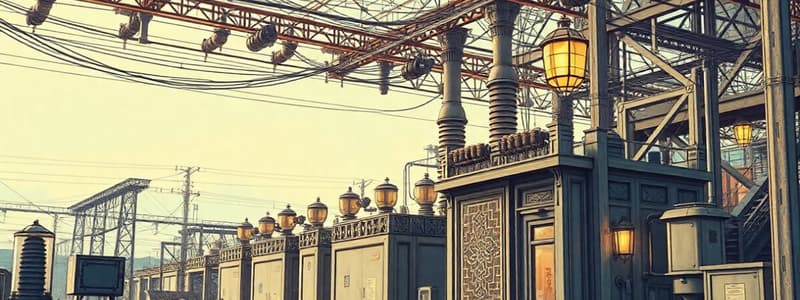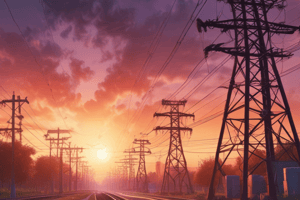Podcast
Questions and Answers
What is the main function of the Master Terminal Unit (MTU) in SCADA systems?
What is the main function of the Master Terminal Unit (MTU) in SCADA systems?
- To acquire data from field devices.
- To provide a human-machine interface for operators.
- To monitor and control processes remotely.
- To display data to operators and send control commands. (correct)
Which of the following applications does NOT typically utilize SCADA systems?
Which of the following applications does NOT typically utilize SCADA systems?
- Social media management. (correct)
- Traffic control systems.
- Water distribution monitoring.
- Oil and gas pipeline monitoring.
What is a significant challenge faced by SCADA systems?
What is a significant challenge faced by SCADA systems?
- Improving user interface design.
- Ensuring continuous operation and reliability. (correct)
- Enhancing marketing efforts.
- Expanding social media integration.
Which component is responsible for monitoring and acquiring data from field devices in a SCADA system?
Which component is responsible for monitoring and acquiring data from field devices in a SCADA system?
What benefit do SCADA systems provide in terms of regulatory compliance?
What benefit do SCADA systems provide in terms of regulatory compliance?
What is a primary safety feature of HVDS systems?
What is a primary safety feature of HVDS systems?
How does distribution automation improve reliability?
How does distribution automation improve reliability?
Which of the following is NOT a benefit of automated distribution systems?
Which of the following is NOT a benefit of automated distribution systems?
What function do feeder automation systems primarily serve?
What function do feeder automation systems primarily serve?
Which of the following does distribution automation NOT support?
Which of the following does distribution automation NOT support?
What is a characteristic of self-healing networks in distribution systems?
What is a characteristic of self-healing networks in distribution systems?
What key role does SCADA play in feeder automation?
What key role does SCADA play in feeder automation?
Why is data analysis important in distribution automation?
Why is data analysis important in distribution automation?
What is the primary purpose of step-down transformers in the distribution system?
What is the primary purpose of step-down transformers in the distribution system?
Which type of electricity distribution line typically carries voltages above 600 volts?
Which type of electricity distribution line typically carries voltages above 600 volts?
What function do distribution transformers serve?
What function do distribution transformers serve?
Which type of conductor is specifically designed for underwater transmission lines?
Which type of conductor is specifically designed for underwater transmission lines?
What is the primary function of a switching substation?
What is the primary function of a switching substation?
What differentiates secondary distribution lines from primary distribution lines?
What differentiates secondary distribution lines from primary distribution lines?
Which type of circuit carries electricity from panelboards to outlets and appliances?
Which type of circuit carries electricity from panelboards to outlets and appliances?
Which type of substation is characterized by equipment mounted on support structures in an open area?
Which type of substation is characterized by equipment mounted on support structures in an open area?
What characterizes bare conductors used in overhead power lines?
What characterizes bare conductors used in overhead power lines?
What advantage does a Gas-Insulated Substation (GIS) provide over a Conventional Air-Insulated Substation (AIS)?
What advantage does a Gas-Insulated Substation (GIS) provide over a Conventional Air-Insulated Substation (AIS)?
What type of distribution system includes insulation covered with PVC or XLPE?
What type of distribution system includes insulation covered with PVC or XLPE?
Which equipment in a substation is responsible for interrupting electricity flow during faults?
Which equipment in a substation is responsible for interrupting electricity flow during faults?
What is the primary role of disconnect switches in a substation?
What is the primary role of disconnect switches in a substation?
How do capacitors and reactors improve the performance of an electrical system in a substation?
How do capacitors and reactors improve the performance of an electrical system in a substation?
What is the function of protection relays in a substation's electrical system?
What is the function of protection relays in a substation's electrical system?
Which type of substation is specifically designed for integrating power from renewable sources?
Which type of substation is specifically designed for integrating power from renewable sources?
What is the primary function of a grounding system?
What is the primary function of a grounding system?
Which bus-bar arrangement provides redundancy and allows for maintenance without disrupting power supply?
Which bus-bar arrangement provides redundancy and allows for maintenance without disrupting power supply?
What is the role of a circuit breaker in an electrical system?
What is the role of a circuit breaker in an electrical system?
Which device is specifically used for power factor correction or voltage support?
Which device is specifically used for power factor correction or voltage support?
In a double bus-bar arrangement, what is the purpose of having two parallel bus-bars?
In a double bus-bar arrangement, what is the purpose of having two parallel bus-bars?
Which of the following arrangements involves isolators to maintain sections independently?
Which of the following arrangements involves isolators to maintain sections independently?
What does a voltage transformer (VT) primarily measure?
What does a voltage transformer (VT) primarily measure?
What can be said about the duplex bus-bar arrangement?
What can be said about the duplex bus-bar arrangement?
Flashcards are hidden until you start studying
Study Notes
Substations: Overview
- Switching Substations control electricity flow.
- Indoor Substations housed within buildings.
- Outdoor Substations equipment mounted outside.
- Hybrid Substations combine indoor and outdoor features.
- Conventional Air-Insulated Substations (AIS) use air as insulation.
- Gas-Insulated Substations (GIS) employ sulfur hexafluoride (SF6) for smaller footprint and environmental benefits.
- Hybrid Gas-Insulated Substations combine GIS and AIS for optimized performance.
- Mobile Substations are portable for emergencies.
- Renewable Energy Substations are designed for solar and wind power.
Major Equipment Of Substation
- Transformers adjust voltage levels for transmission and distribution.
- Circuit Breakers interrupt power flow during faults or overloads.
- Disconnect Switches isolate equipment for maintenance or emergencies.
- Busbars conduct electricity between components.
- Capacitors and Reactors improve power factor and control voltage.
- Voltage Regulators stabilize voltage fluctuations.
- Switchgear includes switching, controlling, and protective equipment.
- Protection Relays monitor for abnormal conditions and signal circuit breakers.
- Control Panels display equipment status and allow adjustments.
- Battery Banks and Chargers provide backup power in outages.
- Instrument Transformers measure voltage and current.
- Grounding System safely dissipates fault currents.
Graphical Symbols For Substation Apparatus & Circuit Elements
- Transformer: Represents a transformer.
- Circuit Breaker: Represents a circuit breaker.
- Disconnect Switch: Represents a disconnect switch.
- Busbars: Represents busbars.
- Lightning Arrestor: Represents a lightning arrestor.
- Isolator: Represents an isolator.
- Capacitor Bank: Represents a capacitor bank.
- Current Transformer (CT): Represents a current transformer.
- Voltage Transformer (VT): Represents a voltage transformer.
- Grounding (Earthing): Represents grounding.
Types Of Bus-Bar Arrangements
- Single Bus-Bar Arrangement: Economical, but offers no redundancy.
- Double Bus-Bar Arrangement: One bus-bar in operation, the other as a standby. Provides redundancy.
- Main and Transfer Bus-Bar Arrangement: A main bus-bar for normal operation, a transfer bus-bar for maintenance.
- Sectionalized Bus-Bar Arrangement: Bus-bar is divided into sections, each with its own isolation switch.
- Ring Main Unit (RMU): Bus-bars arranged in a ring. Enhances reliability.
- Duplex Bus-Bar Arrangement: Similar to double bus-bar but provides even more redundancy.
- Zonal Interlocking Bus-Bar Arrangement: Only one section can be energized at a time for maintenance.
Power Distribution Overview
- Step-Down Transformers reduce voltage for distribution.
- Primary Distribution Lines carry stepped-down electricity through overhead lines or underground cables.
- Distribution Transformers further reduce voltage for homes and businesses.
- Secondary Distribution consists of low voltage lines, service drops, panelboards, and circuit breakers.
Key Differences Between Primary and Secondary Distribution
- Voltage Level: Primary Distribution uses higher voltage, Secondary uses lower voltage.
- Infrastructure: Primary Distribution uses larger long-distance lines, Secondary uses smaller lines for localized distribution.
- Transformers: Primary Distribution uses step-up transformers and step-down transformers, Secondary Distribution uses distribution transformers.
Types Of Conductors In Distribution Systems
- Overhead Conductors:
- Bare Conductors: Uninsulated conductors for overhead lines.
- Covered Conductors: Insulated with weather-resistant materials.
- Underground Conductors:
- Insulated Conductors: Copper or aluminum with PVC or XLPE insulation.
- Shielded Conductors: Have additional shielding to prevent interference.
- Submarine Conductors: Designed for underwater lines.
- High-Temperature Conductors: Withstand higher temperatures.
- Composite Conductors: Made of different materials.
Distribution Automation: Need For Distribution Automation
- Reliability Improvement: Reduces outages and improves restoration speed.
- Cost Savings: Reduces manual labor, maintenance, and energy waste.
- Increased Efficiency: Optimizes power flow and manages voltage.
- Safety Enhancement: Minimizes manual interventions.
- Integration of Renewable Energy: Manages renewables' variability.
- Data-Driven Decision Making: Improves infrastructure management.
- Support For Smart Grid Initiatives: Distribution automation is a key component of smart grids.
Feeder Automation
- Feeder Automation Systems are automated distribution systems.
- Monitoring: Monitors voltage, current, frequency, and power factor.
- Control: Manages switches, breakers, and reconfigures the network.
- Fault Detection and Localization: Identifies and locates faults.
- Self-Healing: Automatically reconfigures the network to restore power.
- Integration With SCADA: Integration with supervisory control and data acquisition (SCADA)systems.
- Security: Protects systems from unauthorized access and tampering.
Supervisory Control and Data Acquisition (SCADA) Systems
- Definition: SCADA systems monitor and control processes and infrastructure.
- Components:
- RTUs/PLCs: Acquire data and control field devices.
- Master Terminal Unit (MTU): Collects data, displays it, and sends control commands.
- Human-Machine Interface (HMI): Allows operators to interact with the system.
- Communication Infrastructure: Connects RTUs/PLCs with the MTU.
- Applications: Utilities, Manufacturing, Transportation, Oil and Gas.
- Benefits: Improved Efficiency, Safety, Cost Savings, Regulatory Compliance.
- Challenges: Security, Integration, Reliability.
Studying That Suits You
Use AI to generate personalized quizzes and flashcards to suit your learning preferences.




